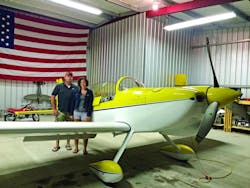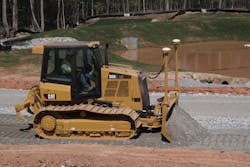Utilization Gains, Data Have Lane Poised for Growth
Dan Breunig, EMS, mechanical supervisor for The Lane Construction Corp., a company specializing in heavy civil construction services and products in the transportation, infrastructure, and energy industries nationwide, arrived from T.J. Lambrecht, a now-shuttered firm that was a big earthmover in Illinois.
At Lambrecht, Breunig was used to working on concentrated job sites stressing earth work, and he brought some ideas of his own to Lane’s wide, multidisciplined Midwest territory.
“At the end of my tenure with Lambrecht, I took care of some larger projects that were out of town,” Breunig says. “For instance, we did quite a bit of road work in Arkansas for three or four years when things were slow, and after that we did an intermodal facility in Kansas City.
“At that project, we had 33 haul units alone, and you’re talking about a fleet of 70 pieces of heavy equipment burning about 8,000 gallons of fuel a day,” Breunig says.
Our Under 40 in Construction Equipment winners are young people under the age of 40 and represent exciting potential for the industry.
This is another in a series of profiles that highlight winners past and present. Apply now for the 2018 program.
At Lane, Breunig is dealing with assets closer to home in a region that includes Illinois and all the states bordering it, though for the time being, the pieces he oversees at peak season are primarily in Northern Illinois and St. Louis.
“The fleet is mostly earth excavation, dozers, excavators, and articulated trucks,” Breunig says. “I’m starting to get exposed to concrete paving a little bit, but I’ve never really been around asphalt.”
Breunig handles his region’s equipment needs from acquisition, including equipment leasing, rental, and purchase, to maintenance.
One of the ideas Breunig has brought with him to Lane is increasing the use of towed scrapers.
“It seems like the whole world has gone to top loading ADTs,” Breunig says. “I think that getting back into more traditional scrapers, like a truck-towed scraper, something that the guys at Mobile Track Solutions (MTS) build, can increase your utilization.”
MTS is an Iowa company Breunig has fostered a close relationship with since his days at Lambrecht. It makes towed scraper models that replace the dump bodies on ADTs. Breunig has been involved in testing and has provided feedback.
“With this type of towed scraper, we can have the same power unit working whether we’re top loading the truck or push loading scrapers,” Breunig says. “Using the same power unit gives us better utilization out of the same piece of equipment.”
Breunig says this kind of move has the potential to increase utilization by 50 percent for a fleet of ADTs, provided the fleet has enough of the appropriate work.
“The days of having a yard full of scrapers are over,” he says. “You have to keep all your equipment working as much as you can. In a nutshell, that’s what it’s all about.”
Other seasoned earth work veterans made the move from Lambrecht to Lane along with Breunig. “In our office, we have a lot of Lambrecht people in our estimating and engineering staff who are very familiar with earth work, so a lot of the different Lane projects lean on us when earth work comes up for them. Lane’s management has been great—they’ve been very open to ideas.”
Breunig is no stranger to ingenuity. While at Lambrecht in 2006 and 2007, Breunig and co-worker Brent Ohlendorf found a way to integrate GPS grade control with the first electro-hydraulic (EH) controlled dozers.
“Before the equipment went from pilot control to full EH, the electro-hydraulic actuation from the cab to the blade, everybody had the pilot system all figured out and they were a little nervous about how to make things work with the new controls,” Breunig says.
“Back then, they piggybacked another valve, another proportional valve, alongside of the equipment’s stock valve,” he says. “We came up with a harness to make it work with the new controls. As with all good ideas, shortly thereafter Topcon was very interested in taking a look at that, and then they had one, too.
“At that time, Lambrecht was, as Lane is too, very open to new ideas and embracing technology. And by doing that, sometimes you’re on the cutting edge and you’re the first one to do something, so you have to make it work even if the OEM hasn’t figured it out yet,” he says.
“Back then, equipment guys and the GPS guys were very different people. Caterpillar and Trimble hadn’t gotten together on AccuGrade much, so putting the GPS equipment on the machines was up to the customer or a third party. We just did it ourselves. You had to make the machine go, so that’s what you did.”
Breunig is now working to increase telematics use in his fleet, working with OEMs and third-party vendors.
“We use the OEM telematics when they have them, and on pieces that wouldn’t have them, or long-term rented pieces, we use Zonar. And then that’s managed both locally and regionally. The hours all go into our equipment-management software,” Breunig says.
The HCSS Equipment360 operating system helps Lane schedule maintenance. “That’s new to us; we started out just tracking employee time with it,” he says. “Our area is one of the initial areas that are actually running the PMs off that same system. We’re having a lot of success with it.”
Lane is also tracking location and fuel usage. Breunig knows there’s much more data to be had. “There’s some other stuff in there that is useful, but you’ll have to manage it at another level,” he says. “If you’re going to capture all that data, it needs to be organized, processed, and analyzed. And sometimes there’s so much data that unless you have someone dedicated to it, it’s not helpful across the board for the fleet.
“If you want to look at something on a particular piece, it’s available,” Breunig says. “It’s a little difficult having four or five OEMs and a third party, because you’ve got to bring that all together, and that’s not a seamless process yet. But that day is coming.”
Lane also uses technology to track idling.
“Our idling policy comes down from the top,” Breunig says. “Some of the equipment has anti-idling technology on it. We don’t really do anything additional on the equipment, such as implementing a shutdown after five minutes. It is analyzed and tracked with telematics.
“It’s a little easier for us in our area on the excavation side, because when the equipment is running, it’s always running hard, and when it’s off, it’s off,” he says. “That’s different than other areas where they’re running a lot of pipe crews or plants; it seems like the potential for idle time exists a little more for them than for us.”
Breunig tracks maintenance costs, but it’s not as data-driven as some of his other disciplines and relies on a number of face-to-face meetings. “There’s no magic formula we use for replacing equipment,” he says. “That’s managed locally first. Choices are narrowed down to pieces with potential issues, the ones we feel are the problem children.”
Much of Breunig’s fleet is Tier 4. He’s had good luck with maintenance and performance.
“So far, so good on Tier 4,” he says. “They seem to have the same or increased power in a given size class of a machine. The fuel efficiency has increased, and because we do the proper maintenance according to the manufacturer—that’s the EGR, crankcase, ventilation filters, and things like that—we haven’t had a tremendous amount of issues. Proactive maintenance is a big thing with Tier 4. I don’t think you’re going to be able to ignore the maintenance intervals and have success.”
Breunig also has advice for managers regarding succession.
“Keep transparency with your people and grow them within the company to advance,” he says. “It’s good to have internal succession. I think it makes everyone a little more invested in the goal of the company. Everybody has to believe and buy into what they’re doing to get the level of dedication needed to be successful. If the people under me can see everything I’m doing, they’ll be ready to operate at the next level.”
He also stresses accountability, a concept reinforced by training to be a single-engine airplane pilot.
“I think that training forces you to have a lot of accountability, because failure’s not an option up there. You have to be accountable for what you’re doing, otherwise it’s going to kill you. Follow through on everything.”


